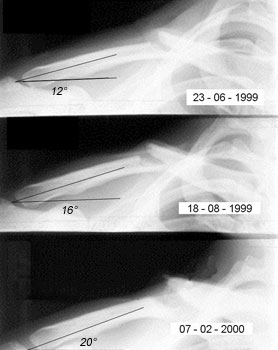Mr Y.F. Here is his story I was born in May 1967. I live in a city that is now famous for its spring music festival, but also, although it is sometimes forgotten, for its ecological film festival. My story could have taken place to the sound of the violins, or in the shade of a movie screen. In fact, my passion is tennis, and I teach it. I am classed 15. I'm 1.80 m tall and I weigh 63 kg. But my career could have ended when I was only 33 years old. In June 1999, I had a motorcycle accident in which I broke my collarbone. It's a fairly common occurrence. What is less so is that the bone did not consolidate. I had cancer of the tongue when I was 24 years old. The ganglions on both sides of my neck were removed, and I received radiotherapy treatment above both collarbones. I was examined by an expert in January 2000, because I had not been operated by surgeons after my accident, and I was feeling more and more discomfort in my arm. I had contractions in my cervical muscles. I couldn't raise my right arm or lie on my right side. I felt very weak. I had to quit playing tennis competitively. This is what the expert concluded after examining my right shoulder. There was a lump under my skin (2 cm). The skin was sensitive to pressure and appeared inflamed. The inflamed area was mobile. There was a scar of 10 cm in length on either side. I couldn't put my right hand behind my back above the level of my hips. My right arm measured two centimeters less in circumference than my left arm (I am left handed, which might explain the difference in muscle mass between the two arms). I didn't know what to do. I couldn't use this arm to throw a ball. I was 33 years old. I didn't want to find a new career. I didn't complain. But up until then life had not been very kind to me. The surgeons didn't want to or couldn't operate. I read that there was a technique in which coral was used to replace bone tissue. I went to consult a surgeon to find out if there was anything he could do. I didn't have much hope. After listening to my problem, examining my shoulder and looking at the x-rays, the surgeon gave me five options: He explained the advantages and disadvantages of each option. He explained that a graft was necessary because there was a hole that needed to be filled between the two parts of the bone. Most surgeons took bone (the graft) from the hip. Since it would be my own bone, there was no risk of rejection, the graft would be accepted by my organism. The disadvantage was that this would be painful and that it would require a second operation. He explained that the advantage of coral is that is was like a bone graft, on the condition that cells were added to it that were identical to those in the bone marrow. There was no risk of rejection, because the product was entirely mineral. He also told me about the risks. No one could know how my skin would react as a result of the radiation treatment I had undergone, nor how it would be affected by the bone protrusion beneath it. Finally, he didn't know the condition of the broken bone which had been irradiated. He told me that he couldn't guarantee that the bone would become consolidated if it had been destroyed by the radiation, but that if the bone was alive there were very good chances of success. He added that in life one has to know when to take chances, and that this should be my decision. He added that even in the worst case scenario, the situation would not be much worse than before. He asked me to think it over and let him know once I had made a decision. The operation took place in June 2006. I agreed to the fifth solution, to have a coral graft and the two parts of the bone secured by a steel plate. The pieces of the bone that were examined in the course of the operation were alive. The surgeon said I had a very good chance of getting better. When I left the clinic, my arm was held by a simple sling. He advised me not to put any weight on it, to use my hand without making any physical efforts in the first few months. The stitches were removed after two weeks. My skin, which had been very red, has returned to its normal color. My shoulder, which had been drooping, has become rounded again. The cramps have disappeared. As I became aware of the improvements, I began to regain hope that all would go well.
Perfect! |
||||||
